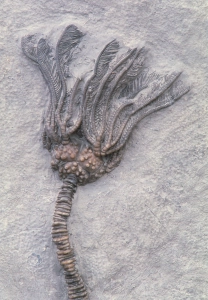
Collectors with a keen eye love to find these tiny crinoid fossils intermingled within the sand and debris along the shores of Lake Michigan. The largest in the photo above is just under the size of a dime. One of several common names for crinoids includes “Lucky Stones” which likely came from the honest luck in finding one. These extinct species are also referred to as “Sea Lilies“ explained by their colorful flower-like appearance when living, but they were actually a type of animal. They possessed long branching arms and a midsection that sat atop of a single slender stem, sometimes reaching two meters above the seafloor. Feathery tentacles at the tips of their branching arms trapped tiny food particles floating by in the ocean currents.
Crinoids were sessile creatures, meaning they attached themselves directly to the seafloor or underwater rocks or even sunken wood. A spawning of their offspring from these bottom bound creatures may have resembled the spring releasing of thousands of dandelion seeds blowing by in a gusty breeze.
Crinoid skeleton fossils are usually found broken up into individual “cheerio” shaped sections or partial stems. Each circular section was stacked one over the other forming the entire animal framework. The Native Americans used the fragmented fossilized sections, perfect for stringing, to craft necklaces. Consequently, yet another fitting, common name for them is “Indian Bead”.
Their amazing history dates as early as the Ordovician Period around 500 million-years-ago, although, most fossils are from the Mississippian Period around 345 mya, preserved in limestone. Their fossil remains are found widespread in North America explained by the fact that much more of the continents were covered under warm shallow seas during these time frames. The sea lily crinoids were a dominant feature in the Paleozoic Era seas. Most varieties succumbed to the great Permian extinction around 252 mya, but a few species still live today, although, they subsist in colder deep-water environments and dwarf in length compared to the ancient varieties.
Crinoid Classification
Kingdom: Animalia
Phylum: Echinoderm (means spiny skin, i.e. starfish, sea urchins, feather stars, crinoids)
Class: Crinoid (means flower form)

Investigate eight other fossils found on Lake Michigan beaches I have described here.
All rights reserved © Fossillady 2022


